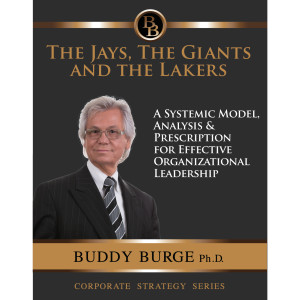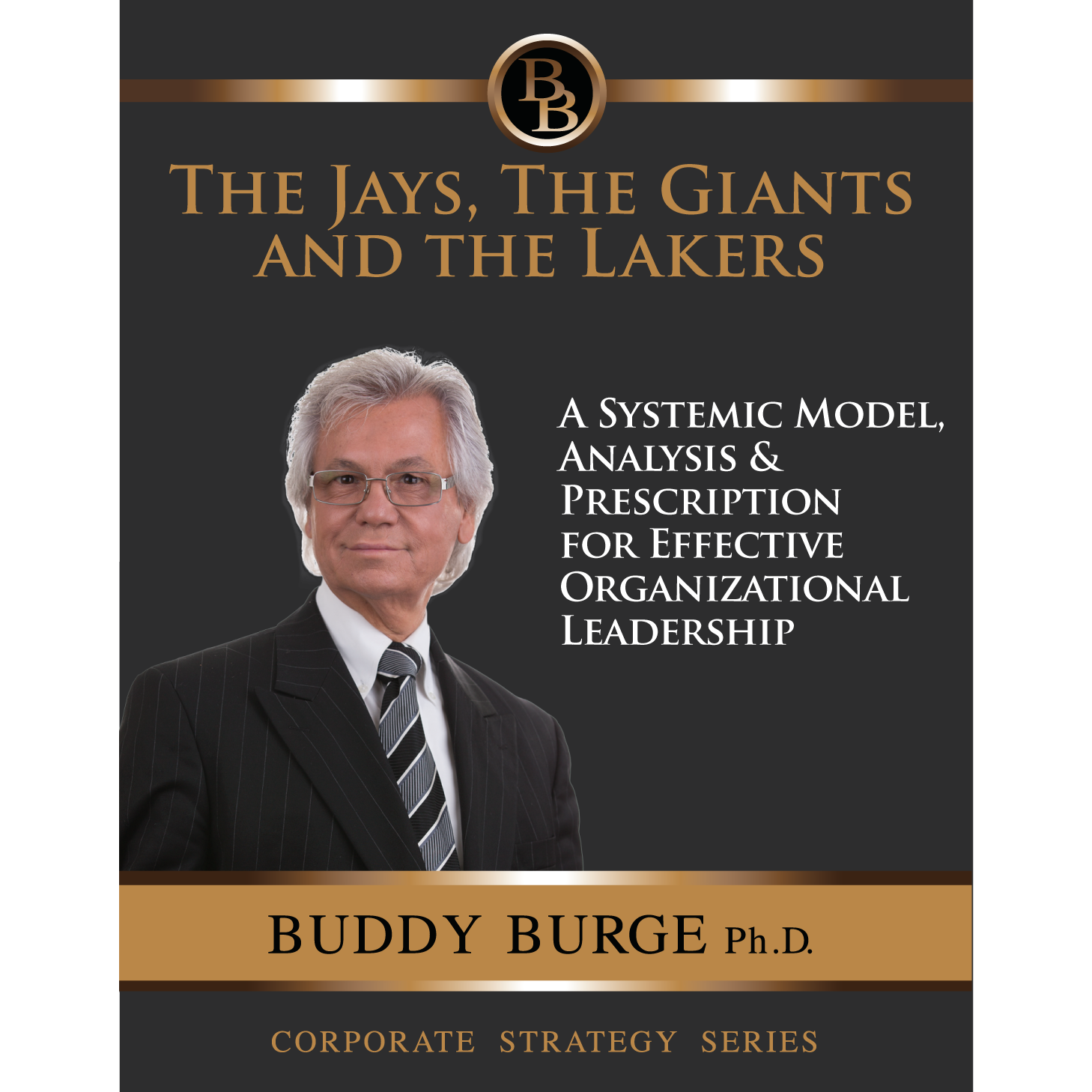The following excerpt is taken from “The Jays, the Giants and the Lakers”
The Three Sports Model for Organizational Structure and Employee Behavior
An Organizational Systems Analogy for the Twenty First Century: Premise
In part one of this excerpt form the Jays, the Giants and the Lakers, we discussed how organizational structure, systems and work interdependence (your business process) are the prime determining factors for high sales volume, customer loyalty, employee performance and productivity.
The role in the organizational system (and its’ attendant and requisite tasks) that people are called upon to play is the most powerful determinant to human behavior in any company.
We also noted that fortuitously, the three major team sports in North America, Baseball, Football and Basketball, which for our purposes is interchangeable with Hockey are a model (reflect, reveal and determine in concrete terms) for the three business systems consistently but unwittingly used by modern organizations to effectively run their operations.
Lastly, asserted that there is a two-part strategic question a leader must ask to clarify which systemic game is at play in the current situation.
That question is:
Given the task at hand:
1. Are We Playing the Right Game?
2. Are We Playing the Right Game, in the Right Way?
In this section we will discuss the practical implications and applications of the Three Sport Organizational Model.
There is no Such Thing as the Right Organization
The first thing to highlight is that there is no right organizational system.
There are only organizational systems, each of which has distinct strengths, distinct limitations and specific applications depending on what will best help you accomplish the task at hand.
Organization is not an absolute. It is a tool for making people productive as they work together (various types of teams) depending on what will best help you accomplish the task at hand.
Certain organizational structures fit certain tasks in certain conditions at certain times.
The company that knows which organizational system (game or context) works best for that given task and adapts best to that system for that moment will have an enormous advantage over those companies who don’t.
The Value of This Analogy
It enables those in conflict to recognize the systemic cause of their dissonance detachedly and objectively.
This helps leader to understand that the issue is that otherwise good people, who are simply doing their “job”, can now instead of blaming each other for the problem between them (a “pissing contest” if you will).
This model also helps diffuse and facilitate said issue, by asking:
- What game are we playing (are we playing the right game)?
- Are we playing the right game, in the right way?
How to Determine Your Systemic Context(s) – Your Primary and/or Secondary Game
The organizational game you play is primarily determined by what will best help you accomplish the task at hand.
If your company’s fundamental challenge or the task at hand calls for:
1. Individual initiative then your primary game (system) is Baseball (Competition).
2. Group compliance then your primary game (system) is Football (Compliance).
3. Spontaneous & coordinated team cooperation, your primary game (system) is Basketball (Cooperation).
The Importance of Systemic Context in Communication
Of the most main and egregious causes of poor communication in modern day organizations is that the sender and the receiver of any given message experience their interaction differently based upon a wide variety of individual factors.
In other places in this program, we have been able to group them into three main categories:
- The Me that is my “Self”
- The Me that is my “Situation”
- The Me that is my “System”
If you are the speaker, it helps enormously to in any significant interaction to contextualize systemically what you are saying so the message being sent is the message being received.
If you are the listener, it also helps measurably to seek feedback from the speaker in any significant interaction to contextualize systemically that feedback the message being sent is the message being received.
On the next page is a suggestion how you can do that.
How to Use Systemic Language in Difficult Conversations
What to Say (Systemically) When Assigning a Task
“Jimmy, with this task let me be clear as to what I am asking you:
1. I need and want this task to be done exactly the way “I” have assigned it (Football – Compliance), that is to say, both the “What” and the “How” are to be done precisely the way I have asked…
2. This project is more of a shared process (Basketball – Cooperation), that is to say, “We” will do the both “What” and the “How” together. So we will need to confer on an ongoing basis both when and how we think we should work on this…
3. This task belongs to “You” (Baseball – Competition), that is to say, both the “What” and the “How” belong to you.
They are your responsibility.
What to Say When Being Assigned a Task
“Boss, I am happy to do this task. Thank you. Are asking me:
1. To simply do the task exactly the way “You” have assigned it (Football – Compliance), that is to say, both the “What” and the “How” are to be done precisely as you have asked…
2. This project is more of a shared process (Basketball – Cooperation), that is to say, “We” will do both the “What” and the “How” together and if so can we talk about when and how you think we should work on this…
3. To simply do the task as “I” think it should be done (Baseball – Competition), that is to say, both the “What” and the “How” belong to me.
They are my responsibility.
How to Have a Direct (Football) Conversation with a Difficult Executive on Your Team
If you are of a more genteel nature and find confrontation difficult, as indeed most of us do, you can contextualize the conversation (take on the role of a benevolent dictator as it were) for the resistant recipient because they cannot and would not do this on their own, even if they could, by saying something like:
“Jimmy, I love how you run your department; we/I am so lucky to have someone as good as you (Baseball: you are a “Star”) and I really like how your work through the process in such a collaborative and cooperative way with our executive team (Basketball).
But this issue is about the organization (Football), so it is my call.
You are suffering with the illusion that this is a conversation.
It is not. I am telling you that this is the direction that we (the organization) are going. In other words, what I am telling everyone is, get on the bus or get off the bus.
And Jimmy, I never want to have this discussion again.
Are we clear about this?”
The Point of Three Sport Organizational Model
The point of this article is to make special note of your primary game and the game of those with whom you may find yourself in conflict.
The rest will further develop your leadership skill as we probe and analyze how:
The three systems companies use (the three games they play) play upon each other
Their characteristics and principles
Their application to your particular situation.
Because systems are living, breathing interconnected entities, if there is something you cannot change (difficult situation person/people), change the part you can (for instance, your language and the part you could not change (people’s behaviour) will change as well.
The leader’s most powerful ally for change is the system, how people are measured or rewarded)
Why is the Sports Model so Helpful?
The sports model will help you;
1. Understand the generic organizational design options.
2. Appreciate and manage the strengths and weaknesses of each option.
3. Relate sports design concepts to your organizational world
4. Implement change successfully and reinforce current practices, as appropriate.
In other words, does our design reflect and fulfill our purpose of being customer driven.
The Three Sports Model Becomes a Practical Design Guide to Help You:
1. Determine in concrete terms, what your company should win at
2. How to organize your company so that you will win.
More Reasons Why the Sports Model So Helpful?
It is helpful to have a concrete, tangible model that can reveal and determine the kind of organizational structure, service process and team experience we need to exceed customer expectations as a matter of course.
1. Each game, as with every organization, is driven by unseen systemic forces and principles that cause specific reactions and behaviour in and by the players.
Sports reporters often lament how ball players tend to be so individualistic as compared to hockey or football players.
2. Without a model, human organization can seem to be or become a capricious, whimsical and slippery thing.
3. Each game is in and of itself – a whole, a complete process.
It represents in dramatic and concrete terms an entire work process. It has a beginning and an end.
4. Gives us an objective view, an overarching representation of our system.
Instead of having to subjectively look “inside out”, from the organizational process of which you are a part, with the sports analogy, you can look objectively from the “outside in”, and see a concrete representation the whole process.
This is a rather systemic, high level and not unsophisticated analysis to and for organizational leadership.
For further explication, I recommend you read the Jays, the Giants and the Lakers in its’ entirety.
I think as a leader, you will find it to be quite useful, strategically so, to be sure.
If, as a leader, you can learn and even master this concept, the macro-systemic causes to people’s behavior and reactions, you will be much further down the road to excellence as a leader and profitability as a company.
For more on this topic, we recommend the following | |
 | The Jays, the Giants and the LakersA Systemic Model, Analysis, and Prescription Click Here For Video and Full Description If you found this article useful |


![CropperCapture[489]](http://buddyburge.com/wp-content/uploads/2014/02/CropperCapture489-277x300.png)
![CropperCapture[490]](http://buddyburge.com/wp-content/uploads/2014/02/CropperCapture490-300x207.png)
![CropperCapture[491]](http://buddyburge.com/wp-content/uploads/2014/02/CropperCapture491-300x154.png)
![CropperCapture[492]](http://buddyburge.com/wp-content/uploads/2014/02/CropperCapture492.png)
![CropperCapture[493]](http://buddyburge.com/wp-content/uploads/2014/02/CropperCapture493-300x235.png)
![CropperCapture[494]](http://buddyburge.com/wp-content/uploads/2014/02/CropperCapture494.png)
![CropperCapture[495]](http://buddyburge.com/wp-content/uploads/2014/02/CropperCapture495-300x198.png)
![CropperCapture[497]](http://buddyburge.com/wp-content/uploads/2014/02/CropperCapture497-300x83.png)
